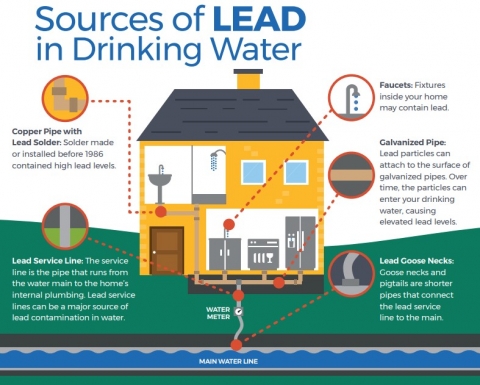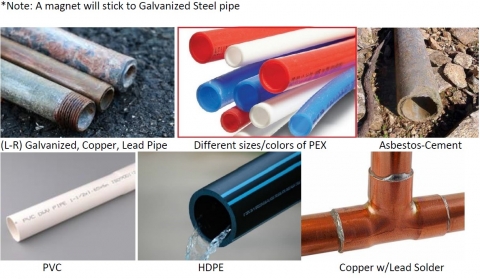
Lead Service Line Inventory (LSLI)
PUBLIC WORKS
Please help us protect your health...
The U.S. Environmental Protection Agency (EPA) recently issued regulations requiring all public water supply (PWS) systems to develop a Lead Service Line Inventory (LSLI) of both water system owned and your privately owned service lines. Your PWS system must submit this inventory to the Kansas Department of Health and Environment (KDHE) by October 16, 2024.
Newsletters were mailed to all current occupants and homeowners within the City of La Cygne the week of September 8 with information about the Lead and Copper Inventory. A hard copy of the survey can be picked up at City Hall or a link to the survey can be found below. Please take the time to respond to the city's inquiries as this will help determine if you or your family have a lead exposure risk. If you are unsure, please contact the city hall for further assistance.
The goal is to remove all lead-containing service lines to your home as piping containing lead can become a potential health risk in drinking water. Some homes (typically built before 1988 in Kansas) may have lead service lines on the customer's property that connect to your water system’s main lines.
Young children, infants, and fetuses are particularly vulnerable to lead in drinking water and water used for formula because the physical and behavioral effects of lead occur at lower exposure levels in children than in adults.
The link to our Lead and Copper Inventory Survey is below
Additional information on the Lead and Copper Rule and identifying lead pipes and plumbing can be found on the KDHE website or EPA websites:
https://www.kdhe.ks.gov/547/Lead-Copper-Rule
https://www.kdhe.ks.gov/409/Public-Water-Supply
https://www.epa.gov/dwreginfo/lead-and-copper-rule
Thank you for your cooperation. If you have any questions or need assistance, please call City Hall at 913-757-2144.
Click HERE for your Printable Survey.
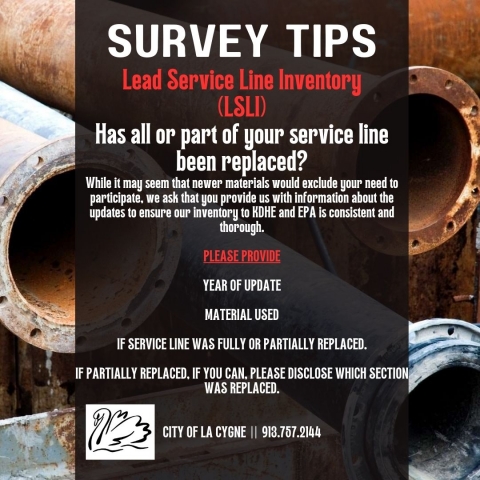
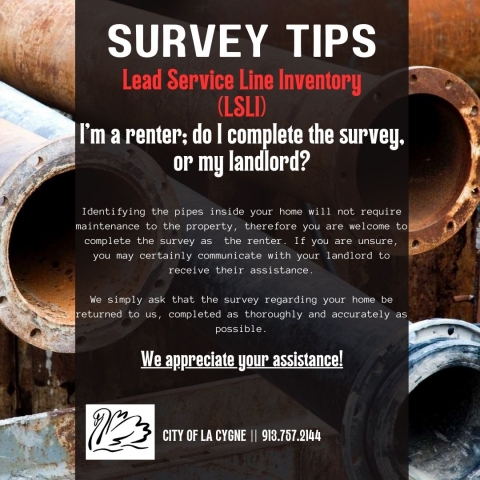
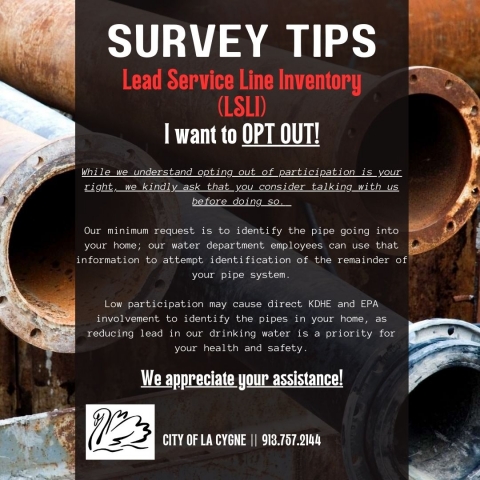
Helpful VIDEO presentation for plumbing pipe identification in your home.
Lead Service Line Inventory Q & A
Q: How much Lead is in our system?
A: The public water supplier is collecting this inventory information to determine this. Assistance from the public is greatly appreciated and to the publics advantage.
Q: Is my yard going to be dug up?
A: The public water supplier is actively searching through our documentation and requesting documentation from the public to prevent this from happening. Some yards will have minimal excavation to help determine what pipes are in the ground.
Q: How can I tell what my plumbing is made of?
A: A customer can look at the service line entering the residence. Look where it comes through the foundation or basement wall. Once the service entry is located, a visual inspection can be done to determine what types of material is used throughout the home. The public water supplier can also send someone to assist the customer in determining what material you have.
Q: What does a lead service line look like?
A: Lead is a dull, soft, non-magnetic material that turns a shiny silver color when scratched. A scratch test can be a simple, quick method for identifying the service line material entering a home or building. If the scratched area turns yellow orange, it is likely copper. Lead will shine. A magnet can also determine the material. If it sticks, it is steel.
Q: Do I have to fill this our if I am a renter of the property?
A: The landlord or owner of the property will be responsible for filling out the requested paperwork and returning it to the city.
Q: Does the inventory require the material identification of both public water supply and the customer-owned portion of the service line?
A: Yes, the public water supply and the customer-owned portion of the service line must be identified. The public water supply lines were all replaced during the water project.
Q: Is the public water supplier responsible for replacing the privately owned part of a service line?
A: The public water supplier is not responsible for replacing the privately owned service line. The property or homeowner will have the freedom to make their decisions on what actions to take.
Q: Where is the physical boundary between the publicly owned and the privately owned section of the service line?
A: The most common transition between the public and private components is at the water meter.
Q: Is visual confirmation required for all service lines?
A: No. Dependable records can verify lead service lines or verify that the line in not lead. In the absence of documents, a visual confirmation will then be needed.
Q: Will the lead service line inventory need to updated?
A: Yes. The inventory must be updated annually.
Q: What is premise plumbing?
A: Premise plumbing is the pipes inside a home that convey water to usage points, such as kitchens, bathrooms, sinks, laundry, etc.
Q: What is the point at which it switches from a service line to premise plumbing?
A: The point at which it switches from a service line coming into the residence and premise plumbing going throughout the residence is the shut-off valve immediately after the service line enters the structure. Often in basements or crawl spaces, just inside an exterior wall and usually an outer wall toward the street side of the house.
Q: What happens if I don't complete the paperwork and return it to the public water supplier?
A: You will be notified several times for this information or until you "Opt-Out" with a signature given to the public water supplier.
Q: What is the cost and procedure to test for lead in my water?
A: Through KDHE, the fees are $9.00 for a lead test and $9.00 for a copper test with 10+ day test results, plus shipping and handling (price subject to change at any time). If you want to have your water tested, please contact City Hall at 913-757-2144.
Q: Does the public water system's personnel have the authority to enter homes to verify a customer-owned service line?
A: The public water system personnel need to have the authority to access your home with permission from the resident. If you need assistance determining the type of pipes you have, our personnel will be happy to assist you.
Q: Can I change my mind later?
A: If you agree to participate and decide not to later, an "Opt-Out" signature is required to no longer participate.
Q: Can I use my hot water for drinking or cooking?
A: Heating of water changes the water's chemistry, making it more likely to dissolve any lead or copper from household plumbing lines. It is not recommended to use hot water unless you know your pipes are lead free.
Q: Does boiling cold tap water reduce lead?
A: No.
Q: What are you putting in the water to control the lead level?
A: Since the plant's water has no lead, we use the Langelier Saturation Index Model to keep the lead from leaching into the water from the piping by maintaining the stability of the water.
